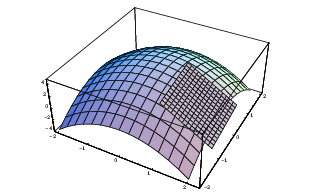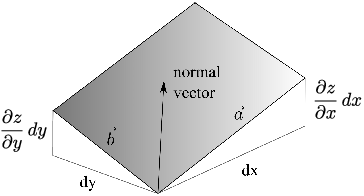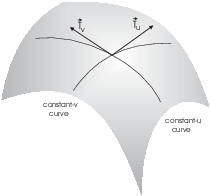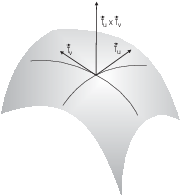The derivative of a function of one variable gives the slope of the
tangent line to the graph. The partial derivatives ![]() and
and ![]() of a function of two variables
of a function of two variables
![]() determine the tangent plane to
the graph.
determine the tangent plane to
the graph.

The graph of ![]() is a surface in 3 dimensions.
Suppose we're trying to find the equation of the tangent plane at
is a surface in 3 dimensions.
Suppose we're trying to find the equation of the tangent plane at
![]() .
.
To write down the equation of a plane, we need a point on the plane
and a vector perpendicular to the plane. We have a point on the
plane, namely ![]() .
.
To find a vector perpendicular to the plane, we find two vectors in the plane and take their cross product. To do this, look at a small piece of the surface near the point of tangency. A small piece will be nearly flat, and will look like the parallelogram depicted below:

The vectors ![]() and
and ![]() which are the sides
of the parallelogram are tangent to the surface at the point of
tangency. Consider
which are the sides
of the parallelogram are tangent to the surface at the point of
tangency. Consider ![]() . It runs in the x-direction. A
small change
. It runs in the x-direction. A
small change ![]() in x produces a change in z --- the amount
the vector
in x produces a change in z --- the amount
the vector ![]() "rises".
"rises".
How much does z change due to a change ![]() in x? The rate of change of z with respect to x is
in x? The rate of change of z with respect to x is
![]() , so the change in z produced by changing x by
, so the change in z produced by changing x by ![]() is just
is just ![]() .
.
Now ![]() is a vector with x-component
is a vector with x-component ![]() , no y-component, and z-component
, no y-component, and z-component ![]() . Therefore,
. Therefore,
![]()
A similar argument shows that
![]()
The cross product is
![]()
I need any vector perpendicular to the surface. Since vectors which are multiples are parallel, I may use this vector as the perpendicular vector to the surface:
![]()
This is often referred to as the normal vector
to the surface and denoted by ![]() .
.
The tangent plane at ![]() is
is
![]()
The normal line to the surface at ![]() is the
line which passes through
is the
line which passes through ![]() and is perpendicular
to the tangent plane. The normal line is parallel to the normal
vector
and is perpendicular
to the tangent plane. The normal line is parallel to the normal
vector ![]() . Therefore, the
parametric equations of the normal line are
. Therefore, the
parametric equations of the normal line are
![]()
Example. Find the equation of the tangent
plane and the parametric equations of the normal line to ![]() at
at ![]() .
.
The normal vector to the surface is
![]()
Plugging in ![]() and
and ![]() gives
gives ![]() .
.
The tangent plane is
![]()
The normal line is
![]()
Example. Use a tangent plane to approximate
![]() .
.
The idea is to think of this as the result of plugging numbers into a
function ![]() . What is f? Well, the form of the
expression suggests that 1.99 corresponds to one of the variables and
1.01 to the other. It's natural to use the function
. What is f? Well, the form of the
expression suggests that 1.99 corresponds to one of the variables and
1.01 to the other. It's natural to use the function
![]()
I want to approximate ![]() . The point
. The point ![]() is close to
is close to ![]() , so I'll use the tangent
plane at
, so I'll use the tangent
plane at ![]() to approximate f.
to approximate f.
The normal vector is
![]()
Plug in ![]() ,
, ![]() . This gives
. This gives ![]() .
.
When ![]() and
and ![]() ,
, ![]() . The point of
tangency is
. The point of
tangency is ![]() .
.
The tangent plane is
![]()
Now set ![]() ,
, ![]() . This gives
. This gives ![]() . (The actual value is 1.989803.)
. (The actual value is 1.989803.)
Here is an equivalent way to think of things that is similar to the
"approximation by differentials" technique you may have
seen in first-year calculus. The change ![]() in f produced by small changes in
in f produced by small changes in ![]() in x and
in x and ![]() in y is approximated by
in y is approximated by
![]()
Thus,
![]()
Here ![]() denotes the "nice" point (
denotes the "nice" point (![]() in the last example) and
in the last example) and ![]() denotes the "ugly" point (
denotes the "ugly" point (![]() in the last example).
in the last example).
If you redo the example using this differential approach, you'd have
![]()
Suppose a surface is given parametrically:
![]()
Consider the vectors
![]()
These vectors are tangent to the curves in the surface
determined by letting one of u or v vary and holding the other
constant. For example, if u varies and ![]() is constant, I get the curve
is constant, I get the curve
![]()
The velocity vector for this curve is ![]() .
.
Likewise, consider the curve obtained by setting u to a constant:
![]()
The velocity vector for this curve is ![]() .
.

The cross product of ![]() and
and ![]() is a normal vector to the surface:
is a normal vector to the surface:
![]()

Example. Find the equation of the tangent plane and the parametric equations for the normal line to
![]()
First, the point of tangency is obtained by plugging ![]() and
and ![]() into x, y, and z. I get
into x, y, and z. I get ![]() ,
, ![]() , and
, and ![]() . The point is
. The point is ![]() .
.
Next,
![]()
When ![]() and
and ![]() ,
,
![]()
The normal vector is

The tangent plane is
![]()
The normal line is
![]()
Copyright 2019 by Bruce Ikenaga